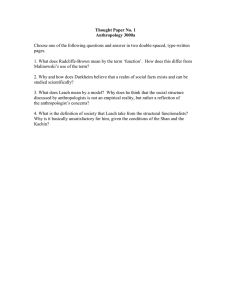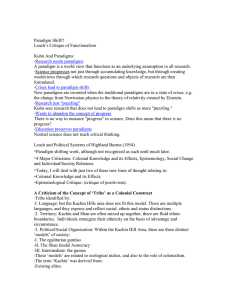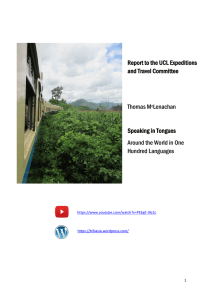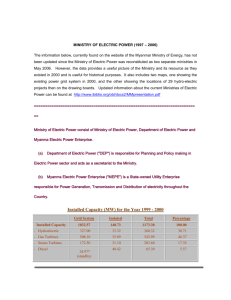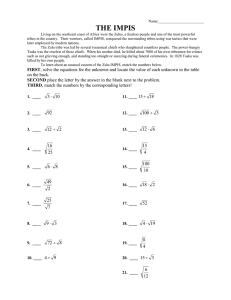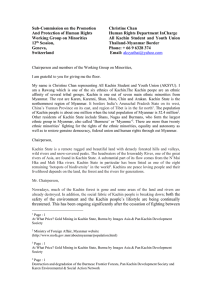Conflict, ‘Cohesion’ and Change Gluckman and Leach
advertisement
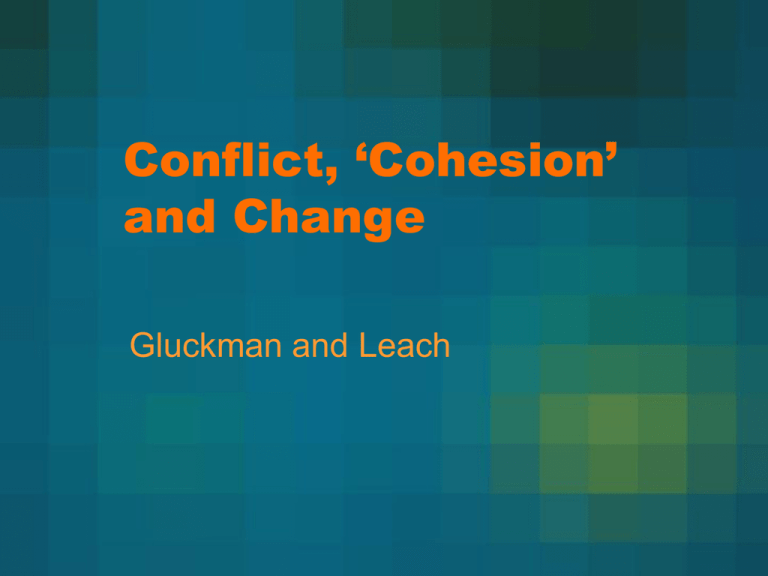
Conflict, ‘Cohesion’ and Change Gluckman and Leach Max Gluckman • Taught and influenced by RB and EP • Grew up in South Africa; concerned about the system of apartheid that had emerged there. • First analysis was of Zulu society: • Saw it as being shaped overall by colonial relations. Introduced a concern with power and oppression. • Also interested in segmentary opposition within Zulu society. • Ruled by a king, but periodic rebellions against the king: • “They were not revolutions, but rebellions against the king in the name of the king.” Ultimately reinforced the office itself. • Social cohesion is not always present: Zulu kingdoms characterized by periods of stability and periods of conflict Victor Turner: Social Dramas and ‘Performance’ • • • • Study of Ndembu society in central Africa. Structural tensions in Ndembu society: Matrilineal and patrilocal. Contradiction in the roles of men as: – Members of a matrilineage. – Women married out. – Fathers, brothers, sons. • Ambitious men tried to bring both their own sons and their nephews into their own residences. • Used extended case studies of tensions, quarrels, and their reconciliation to illustrate how these contradictions were resolved. • Saw ‘social cohesion’ or ‘social order’ as an emergent property from the reconciliation of social dramas. Edmund Leach and Social Change • Studied under Malinowski. • Major study was in the mountains of Burma, today known as Kampuchea. Also did fieldwork in Sri Lanka. • Strongly criticized equilibrium models of RB and EP. • Saw anthropological models as ideal models of other people’s ideal models of their social system Models of Political Organization in the Kachin Hills • Political/Social Organization: Within the Kachin Hill Area, there are three distinct ‘models’ of society: • I. The egalitarian gumlao • II. The Shan feudal Autocracy • III. Intermediate: the gumsa • Ecological differences between the Shan and the Kachin • Shan were involved in irrigated rice agriculture: had centralized states, Buddhism, literacy. • Kachin practised shifting agriculture: no centralized states, little surplus production, organized through patrilineages. Not equilibrium, but change characterized their interrelations • Kachin Hill area characterized not by equilibrium, but by an ‘unstable equilibirum’ in continual oscillation: • Between Gumsa and Gumlao, between social hierarchies and radical egalitarianism. • I. Gumlao: all are of the same status, no village or domain chiefs, social and linguistic factionalism. • II. Gumsa: ideal model is a feudal state, ranked hierarchy in status and politics. Languages ranked in a status hierarchy, with Jinghpaw being the language of the aristocracy. • Both Gumlao and Gumsa communities are unstable, because they contain elements in tension with each other, I.e. internal contradictions Contradictions in the Kachin Hills • Status relationship between those lineages who gave brides and those who received them; wifegivers were of higher status and treated wife-giving lineages as vassals. • At a certain point the wife-giving lineages rebelled and set up egalitarian villages. • However, the kinship terminology continued to differentiate between wife-givers and wifereceivers. • Slowly, a ranked and status-based society emerged again over several generations. • Continual oscillation between these two models. Leach and Descent Groups in Pul Eliya, Sri Lanka • Irrigated rice agriculture; the land-possessing group was the variga, or sub-caste, that consisted of a number of patrilineages. • Kinship rule was that all land should remain within the possession of the variga and not be sold or inherited outside it. • Yet, in quite a few cases, men moved into Pul Eliya to live with their wives’ fathers if they did not have land themselves. • In these cases, the man would be adopted into the variga, so that by a ‘legal’ fiction the system worked. • Leach saw descent groups in Pul Eliya as epiphenomenal, i.e. as emerging out of decisions made by individuals regarding residence after marriage. Conclusions • • • • • • • • Emphasis here is on points of conflict and tension, as well as cohesion, in society; and how this promoted either: 1. Long-term equilibrium, e.g. in rituals of rebellion against the Zulu king. 2. Long-term structural change, e.g. in the oscillating structures of Kachin political organization. Change also results from powerful external influences, such as colonialism. a. Although the source of change might be external, the final result was influenced by the social structures and patterns found in a local society. b. Emphasis on individuals and their actions, and how this produced and reproduced social institutions or led to social change. c. Individuals are seen not merely as embodiments of set social roles, but as creative and manipulative, using social norms to their own advantage and in the process, creating social change. d. Often, the social structures that emerged through individual actions were unconsciously produced.
